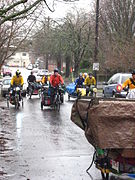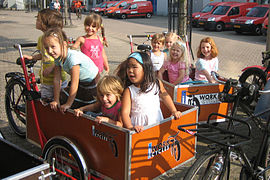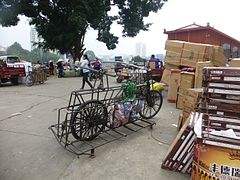Freight bicycle




Freight bicycles, carrier cycles, freight tricycles, cargo bikes, box bikes, or cycletrucks are human powered vehicles designed and constructed specifically for transporting loads. Vehicle designs include a cargo area consisting of an open or enclosed box, a flat platform, or a wire basket, usually mounted over one or both wheels, low behind the front wheel, or between parallel wheels at either the front or rear of the vehicle. The frame and drivetrain must be constructed to handle loads larger than those on an ordinary bicycle.
Development[]
The first freight bicycles were used by tradesmen to deliver mail, bread and milk amongst other things. Early freight bicycles were heavy-duty standard bicycles, with heavy carriers at front or rear, sometimes with a smaller front wheel to accommodate a large front carrier. During the early part of the 20th century these were commonly used by tradesmen for local deliveries. In the UK this style is still sometimes known as a butcher's bike or delibike, although the Post Office have by far the largest fleet.
With the domination of the internal combustion engine in the industrialized countries after World War II, freight bikes became less popular. In the rest of the world, however, they continued to be manufactured and heavily used. In the 1980s in Europe, and the 1990s in the US, ecologically-minded designers and small-scale manufacturers initiated a revival of the freight bike manufacturing sector.
Common uses[]
Freight bikes are used in a variety of settings:
- Delivery services in dense urban environments
- Food vending in high foot traffic areas (including specialist ice cream bikes)
- Transporting trade tools, including around large installations such as power stations and CERN
- Airport cargo handling
- Recycling collections
- Warehouse inventory transportation
- Mail delivery (The UK post office operates a fleet of 33,000 bicycles, mainly the Pashley MailStar)
- Organic Transit boasts that if their ELF is used in place of a car, it could prevent up to six tons of CO2 from spewing into the atmosphere each year. "There is nothing more polluting than driving our cars each day,"[1]
Considerations[]
Freight bicycles have a number of advantages over motorized vehicles:
- They do not create air pollution problems (e.g. enclosed warehouses and industrial plants)
- They are less costly to operate
- They are silent
- They are not limited by the availability of fuel
- They are less dangerous than most of the other road vehicles
- They contribute much less to traffic jams
A limitation of any human-powered vehicle is the relative weakness of human power compared to many motors, leaving a narrow scope for balancing tare weight, payload, geographical and topographical range against each other. These limitations might in some cases dissuade some people from using cargo bikes, whereas others still find them useful, and have been in increasing numbers.[2][3]
Some cargo bike makers and users utilize power assist motors to complement the power of the cyclist. Power assist can increase the payload and range of cargo bikes, but also increases the cost of the bicycle and requires on-board fuel or other energy storage.[4]
Because of the unavoidable physical demands on a driver who also has to propel the vehicle, and the lack of protection against either the elements or other traffic, there is also a potential for working conditions becoming a problem. Technical efforts to improve conditions are hampered by the need for low weight and sturdy simplicity to achieve low costs in small-scale operations.
Types[]

In Amsterdam and Copenhagen, freight bikes are extremely popular. In Amsterdam many residents simply fit large front carriers to sturdy city bicycles. There is also a broad variety of specially made freight bikes including low-loading two-wheelers with extended wheelbases, bicycles with small front wheels to fit huge front carriers, tadpole-type three-wheelers with a box between the two front wheels. Varieties used elsewhere include a platform, basket etc. instead of the box, the loading area between two rear wheels (delta-fashion), small-wheel two-wheelers loading both back and front. An occasional four-wheeler can also be seen, especially within a plant, warehouse or the like, where demands on stability and loading capacity are higher than on range.
Many models are now available with an electric assist which can make them more useful for longer distances or for varied terrain, i.e. not flat cities, amongst other reasons, such as feeling more confident riding in car traffic due to faster acceleration from stopping.
Cycle truck[]
The Cycle truck refers to a type of freight bicycle with a smaller front wheel than rear, typically 26 inches (66 cm) rear and 20 inches (51 cm) front.
Butcher's bike[]

Also referred to as a Baker's bike, however this style of freight bicycle was popular with a wide variety of trades during the first half of the 20th century, particularly in the United Kingdom. Typically, they would have a basket or storage box mounted within a framework which was fixed to the frame (not the fork) of the bike. Often, they would also feature a sign advertising the business concerned, which would be attached within the main triangle of the bicycle frame.[5]
Cycle truck typically also employed the same basket/rack to frame arrangement, as sold by Schwinn's cycle-truck.
Their popularity declined significantly towards the end of the 1950s, with the increase of motorised transport, and their use today is largely limited to postal delivery services.
Boda-boda[]
A boda-boda (or bodaboda) is a two-wheeled bicycle or motorcycle taxi, originally in East Africa. Boda Boda[6] is also the name of Yuba Bicycles compact cargo bike introduced in 2012.
Long John bicycle[]

The Long John Bicycle is a freight bicycle with the cargo area in front of the rider and some linkage connecting the steering to the front wheel, "linkage steering". Capacity is usually about 220 pounds (100 kg). A traditional Long John will have a smaller front wheel and a 23 or 26 in (58 or 66 cm) rear wheel, plus a 30–40 in (76–102 cm) long platform, basket, or box located low, in front of the handlebars.
Recently, the term "bakfiets" (which means "box bike" in Dutch; plural is "bakfietsen") has sometimes been used to describe Long Johns and even cargo bikes, in general.[7] Slightly shorter versions of Long Johns are also sometimes referred to as "cycletrucks".
Vintage Long Johns are becoming collectible. The last known manufacturer to still produce the original Long John is Monark. The history of Long John Bicycles is traced to Denmark c. 1923.[8] The Smith & Co. Company (SCO - founded by Ivar Smith and Robert Jacobsen in Odense, Denmark 17 October 1894) was the inventor and the first to build this type of cargo bicycle. The first Long-John was presented to the public at the Wembley World Fair & Exhibition in 1924.
This style of bicycle is useful for carrying freight but also young children and can function as a car replacement for many families with appropriate safe infrastructure in place in their towns or cities. This is one of the easiest ways to transport very young children (i.e. babies)[9] as the platform or box is large enough to accommodate an infant bucket-style car seat. When children get older, they are often seated on a small bench and clipped in with a 3- or 5-point harness. Canopies are often sold or homemade that can be affixed to the cargo box for protection from the elements, making a warm and inviting space for children to enjoy the ride.
Off-road Long John bicycle[]

The range of Long John style cargobikes extends to off-road applications.[10] Such designs can cover difficult terrain such as sand, mud, and snow, by using fatbike tires, electric motors, and suitable ground clearance. This brings cargobikes into farms, national parks, 1st-response situations, and immunization programs.
Longtail bicycle[]

Longtails have a longer than usual frame wheelbase at the rear compared to a standard bicycle.[11][12][13] The extended rear better facilitates use as a freight bicycle or carrying multiple or adult passengers compared with shorter bicycles. They tend to handle more like regular bikes than cargo bikes with linkage steering.
Xtracycle developed the first longtail product, their Free Radical,[14] which attaches to an existing 'donor' bicycle to make it a longtail bike in 1998. The growing popularity of Xtracycle inspired the Kona Ute,[15] launched for the 2008 season. Surly were asked by Xtracycle to build a complete Xtracycle-compatible frameset; the result was the 'Big Dummy', first released for the 2008 season. The chromoly frameset is designed for 26" wheels.[16] Buyers have the choice of frameset alone or complete bicycle. In 2008 Xtracycle documented the LongTail as an open-source standard.[17] This has helped individuals to build longtail bikes themselves such as the Xtravois.[18]
Xtracycle now offers a complete bike, the Xtracycle EdgeRunner, which allows for safer loading and unloading of children and is easier to handle and accelerate than other longtails because of its small 20" rear wheel.[19]
Since then LongTails have become a bike of choice to be outfitted with Electric-Power Assist systems.
Yuba Bicycles launched the first complete longtail cargo bike with the Mundo.[20] Other complete longtail cargo bikes include the Surly Big Dummy.
Bike Friday has a unique longtail cargo bike, the Haul-a-Day, with a main frame that adjusts in size for riders from 4'0" to 6'6" tall. It is claimed to be the world's lightest longtail cargo bike.[21]
Bike43 has a longtail with a 20" rear wheel to lower the weight of the payload. The goal is to make the bicycle stable even with 2 or 3 children onboard. The frame is made in Europe from Cromoly steel for stiffness strength and durability.[22]
There is a sub-class of longtail bicycles referred to as midtails. As their name implies, they are not quite as long as a longtail, but can still often carry at least one if not two children. The Yuba BodaBoda is one such bike, as are the Tern GSD and HSD. The Bike Friday Haul-a-Day initially fit in this category, but can arguably carry as many kids as an Xtracycle Edgerunner (longtail). The Kona Ute is a longtail, and the Kona Minute is its midtail counterpart.
Wooden freight bicycle[]

The chukudu (or chikudu, cbokoudou) is a two-wheeled vehicle similar to a scooter used in the east of the Democratic Republic of Congo. It is made of wood, and used for transporting freight.
Porteur bicycle[]

A porteur bicycle has the rack on the front, and can carry as much as 50 kilograms (110 lb) that way.
Tricycles[]

Cycle rickshaws are used for the short range transport of both people and goods while tricycles with boxes or platforms are used to transport goods. A cargo tricycle with an open or flat platform might be used for low value goods or for trips where the rider is always with the goods. A fabric cover can be added to provide weather protection. Tricycles can also be fitted with a lockable weatherproof box, usually of aluminium construction, for valuable goods and where the rider has to leave the vehicle.
Cargo tricycles can typically carry 100–300 kilograms (220–660 lb) of cargo and have capacity of 1 cubic metre (35 cu ft) or more, which is about half the capacity of a small panel van. The weight capacity of tricycles is limited by available human power and the permitted power of electric assist by law.
Gallery[]

An old cargo bike in Tel Aviv, Israel
A loaded freight trike being pushed in Jakarta, Indonesia

Cyclists in Portland, Oregon, move a household by bike
Heavy-duty city bike with frame-mounted front carrier known as a "semi-transportfiets" (Dutch for semi-transport bicycle)
Classic Monark Swedish baker's bike, this one with locking aluminium case on the frame-mounted front carrier

Traditional Delibike in Buenos Aires.

Somewhat heavier bike, steered by linkage. Amsterdam, Netherlands.

Cargo trike specially equipped for street cleaning crews; The side and rear compartments carry pick-up sticks, bag holders and other gear.
Child transport is now the most popular use of freight bicycle[citation needed], and numerous special models are offered.
Brazilian cargo bikes are very strong and commonly carry large propane containers, 5x20-gallon water jugs, etc.

Heavy duty cargo trike in Sweden

An Iceni Cycles Chariot trike with aluminium box for local delivery work.

A Bike43 longtail ebike carrying two children
Selected designers and manufacturers[]
- George Bliss
- Jan Van Der Tuin
- Mike Burrows, designer of the 8 Freight
- Pashley Cycles
- Sohrab Cycles, in Pakistan.
- Worksman Cycles
- Xtracycle
- Zigo
- Tern (company), e.g. GSD and HSD models
- Kona Bicycle Company, eg. Ute and Minute models
- Accell, e.g. Babboe and Batavus companies that make cargo/freight bicycles
Freight tricycle[]

See also[]
- Human-powered transport
- Outline of cycling
- Quadracycle (human-powered vehicle)
- electrically-powered four-wheel carts used in the Netherlands
References[]
- ^ "5 Reasons Cargo Bikes Are the Perfect Mode of Transportation". EcoWatch. 2015-02-25. Retrieved 2020-10-30.
- ^ "Promoting Cargo Cycling in the European Union". cargocycling.org. Archived from the original on 23 January 2012. Retrieved 12 April 2013.
- ^ "EU Parliament Listens to Cargo Bike Experts". European Cyclists’ Federation. Archived from the original on 19 June 2012. Retrieved 9 June 2012.
- ^ Giddings, Morgan. "A Quiet Revolution in Bicycles: Recapturing a Role as Utilitarian People-Movers (Part II)". PeakProsperity. Archived from the original on 3 August 2012. Retrieved 15 April 2020.
- ^ http://tradesmansbike.wordpress.com/
- ^ http://yubabikes.com/cargo-bikes/boda-boda/
- ^ Walker, Amy, ed. (2011). On Bicycles: 50 Ways The New Bicycle Culture Can Change Your Life. Novato/California: New World Library. pp. 127, 128. ISBN 9781608680221.
- ^ Dickson, Thomas (2006). Dansk Design. Copenhagen: Gyldendalske Boghandel. p. 392. ISBN 9781741963175.
- ^ "Biking With Babies". This Mom Bikes. March 28, 2018.
- ^ "Anywhere Berlin". Retrieved 2016-05-13.
- ^ "Blog Archive » Longtail Vanilla #1". Clever Cycles. 2006-10-04. Retrieved 2011-04-23.
- ^ Dave R. (January 10, 2008). "Kona Ute—Rock solid cargo bike". Bike Hugger. Retrieved 2011-04-23.
- ^ Justin Thomas. "The Best Cargo Carrying Bikes Of 2009: A Review >> MetaEfficient Review". Metaefficient.com. Retrieved 2011-04-23.
- ^ "Xtracycle". Xtracycle. Archived from the original on 2014-12-30. Retrieved 2014-12-30.
- ^ "konaworld". konaworld. Archived from the original on 2011-03-03. Retrieved 2011-04-23.
- ^ "Spew | Removing and applying decals on our frames". Surlybikes.com. Retrieved 2011-04-23.
- ^ "Main Page - Open Source LongTail Technology". Xtracycle.com. 2009-03-13. Retrieved 2011-04-23.
- ^ "xtravois". Clevercycles.com. Retrieved 2011-04-23.
- ^ "We Tried It: Xtracycle EdgeRunner Assisted and Unassisted". Hum of the City. 2014-06-23. Retrieved 2015-01-25.
- ^ http://yubabikes.com/cargo-bikes/mundo/
- ^ "Archived copy". Archived from the original on 2016-07-30. Retrieved 2016-06-19.CS1 maint: archived copy as title (link)
- ^ http://www.bike43.com
| Wikimedia Commons has media related to Freight bicycles. |
| Look up bakfiets in Wiktionary, the free dictionary. |
- Appropriate technology
- Cycle types














